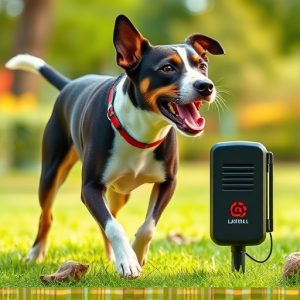Mastering Sonic Repellent Training Levels: Effective Animal Deterrence
Electronic animal repellents, using ultrasonic sounds or electromagnetic fields, offer a humane and…….
Electronic animal repellents, using ultrasonic sounds or electromagnetic fields, offer a humane and eco-friendly way to deter wildlife with adjustable sonic training levels. By customizing sound frequencies, intensities, and durations, users can target specific species' sensitivities, making them effective across diverse landscapes and needs. This feature ensures minimal distress to non-target wildlife while teaching animals to associate the sounds with negative experiences. Lower settings are suitable for urban environments or pet training, while higher levels are more effective against larger wildlife over longer distances.
“Discover the future of pest control with electronic animal repellents—a humane and effective solution for deterring unwanted critters. This comprehensive guide explores the inner workings of these innovative devices, shedding light on how they utilize sound waves to create a safe, yet powerful barrier. We delve into the various training levels offered by sonic repellent systems, emphasizing the importance of Adjusting Sonic Repellent Training Levels for optimal performance and user safety. Get ready to explore features, settings, and tips for choosing the perfect repeller.”
- Understanding Electronic Animal Repellents: How They Work
- The Role of Sonic Repellent Training Levels
- Features to Consider in Choosing the Right Repellent Device
- Adjusting Sonic Settings for Effective Training and Safety
Understanding Electronic Animal Repellents: How They Work
Electronic animal repellents are innovative devices designed to deter unwanted wildlife from entering specific areas, offering a humane and eco-friendly alternative to traditional chemical repellents. These repellents work by emitting various forms of energy, such as ultrasonic sounds or electromagnetic fields, which animals find unpleasant. When an animal approaches the protected zone, sensors detect their presence and trigger the repellent mechanism.
One unique feature of electronic repellents is the ability to adjust sonic repellent training levels. These devices can be programmed to emit different frequencies or intensities of sound, allowing users to customize the sensitivity level based on the target species and environmental conditions. By gradually increasing the intensity, animals can learn to associate the sound with a negative experience without causing them harm. This adjustable training feature ensures effective protection while minimizing any potential distress to non-target wildlife.
The Role of Sonic Repellent Training Levels
The effectiveness of electronic animal repellents, often referred to as sonic repelents, lies in their ability to emit sound waves designed to deter animals from specific areas. Adjusting Sonic Repellent Training Levels plays a crucial role in optimizing this effectiveness. By manipulating the frequency, intensity, and duration of the emitted sounds, users can target different species with varying sensitivities to sound. For example, higher frequencies may be more effective against smaller birds, while lower frequencies might better deter larger animals like deer or wild boars.
Furthermore, adjusting training levels allows for personalized settings based on environmental factors. In urban settings, where noise pollution is a concern, lower volume levels can ensure the repellent remains effective yet discreet. Conversely, rural areas may require higher settings to penetrate background noises and reach targeted animals effectively. This flexibility in sonic repelent training empowers users to tailor their devices to specific needs, enhancing their overall utility for animal control.
Features to Consider in Choosing the Right Repellent Device
When selecting an electronic animal repellent, several features come into play to ensure its effectiveness and suitability for your needs. One key aspect is the ability to Adjusting Sonic Repellent Training Levels. These levels allow users to customize the intensity of the sound output, which is crucial as different animals have varying sensitivities to sound. For instance, a higher training level might be necessary for larger wild animals like deer or bears, while smaller pests like squirrels or rabbits may respond better at lower settings.
Additionally, look for devices with adjustable frequency ranges. Animals have specific hearing ranges, and certain frequencies are more effective in repelling them. Some repeellers offer multi-frequency settings, enabling you to target specific species effectively. This feature is particularly useful if you’re dealing with a mix of animals, ensuring the repellent sound is tailored to each.
Adjusting Sonic Settings for Effective Training and Safety
When using an electronic animal repellent, adjusting the sonic settings is crucial for effective training and ensuring safety. These devices emit high-frequency sound waves designed to deter animals, but the intensity and tone can be tailored to different situations. By modifying the training levels, users can find the perfect balance between effectiveness and comfort. Lower settings are ideal for sensitive areas or when training pets, allowing them to learn the repellent’s signal without being overwhelmed. Higher levels, on the other hand, are more suitable for repelling larger wildlife, as they emit stronger sounds that can be heard over longer distances.
The key to successful adjustment is understanding your environment and the animals you aim to repel. Different species have varying sensitivities to sound. For instance, dogs may require lower settings, while cats might need higher ones. Additionally, terrain and weather conditions can affect sound propagation. Adjusting the sonic repellent levels accordingly enables users to customize the device’s performance, ensuring it remains effective yet safe for both animals and humans in the vicinity.
Electronic animal repellents, with their versatile features like adjustable sonic levels, offer a humane and effective solution for managing unwanted wildlife. By understanding how these devices work and carefully tailoring the sonic settings, users can achieve successful animal training while ensuring safety and minimizing environmental impact. With the right combination of features and adjustments, electronic repellents are a game-changer in maintaining a harmonious coexistence with nature.


